Stranded
This first-person story was based on my experience of two mass strandings of pilot whales, the first on Karikari Beach in New Zealand’s Far North in August 2010; the second at Spirits Bay, about 100km further north, just one month later.
The first thing that hit me was the screaming.
I’d just climbed the dunes to get to my first mass stranding, and I’d braced myself for a distressing sight.
What I didn’t expect was the sound whales make when they’re stuck fast on the sand, freaking out and convinced they’re about to die.
It’s a high-pitched wail, somewhere between a child crying for its mum and a dolphin’s normally cheerful squeak. It’s a sound full of fear and confusion, begging for reassurance from its pod-mates – but they’re just as stuck, out of their element, transformed from sleek creatures of the sea to helpless mounds of blubber, like rubber props left over from filming Whale Rider.

The sound came from all directions at once and, I’ll be honest, it did my head in.
For those first few hours on August 20, the day 58 pilot whales were found stranded on Karikari Beach, I stumbled around almost as useless as the beached whales. My notebook stayed blank, my camera zipped away in its bag.
My job takes me to plenty of car crashes, but by the time I turn up the patients are usually sedated and in the capable hands of medics. I’ve never been to a crash and found a few dozen accident victims scattered across the road calling for help.
It was the kids that pulled me together.
Among them was nine-year-old Lucy Hale of Houhora, unfazed by the dead and dying creatures around her, tending to her whale calf.
It had already been pulled up the beach above the high-tide mark — ironically, the greatest risk to a beached whale is drowning due to waves driving water into its blowhole — so Lucy was keeping it wet and cool with buckets of water.
She was also chatting to her whale, as if it was a schoolmate with a stubbed toe in need of comfort.
“You’ve got to keep them wet and keep talking to them, telling them it’s going to be okay,” she said.
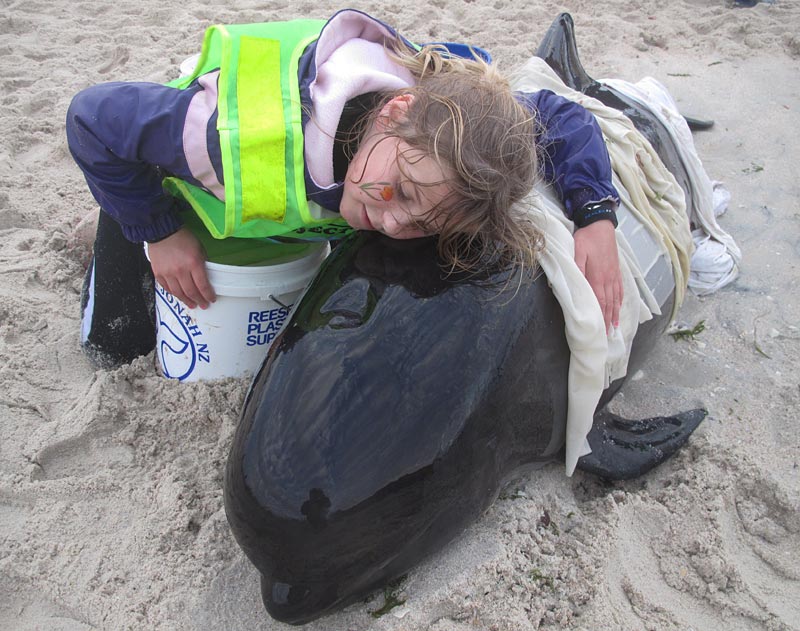
And that brings me to the second thing — after the whales’ wails — that’s etched permanently in my head after two mass strandings in just over a month.
Amid the chaos and stench and suffering, it was the tenderness.
The groups involved in whale rescues — Project Jonah, Far North Whale Rescue and the Department of Conservation — go to great lengths to keep each whale with its own humans.
The whales understand they are being helped, and bond with the people helping them. Distressed whales also calm down when spoken or sung to, they say.
Now I’m a bit of a sceptic — it’s almost part of my job description — so I was amazed to see what happened each time little Lucy went back to the breakers for another bucket of water.
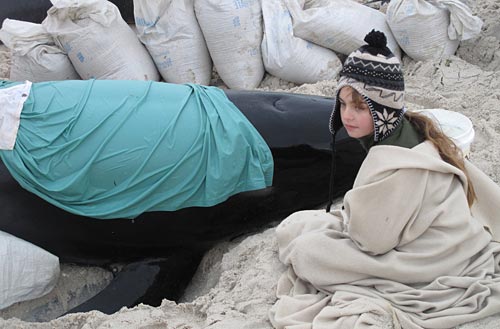
I’d try to reassure her calf, but it wouldn’t have a bar of it. Its wails would go up an octave or two, its breathing became shallower and faster, and its eyes darted around madly.
Then Lucy would return, and her calf would calm down again.
I saw that repeated many times during the Karikari and Spirits Bay rescues. I also saw it wasn’t just the whales bonding with their humans.
The Jones sisters of Whatuwhiwhi – there’s four of them, ranging in age from seven to 13 – helped out at both rescues, and were all but inseparable from their whales.
I’d see them just after sunrise, wrapped in blankets against the morning chill and with eyes barely open, but still sitting with their whales.
All night volunteers from as far away as the Waikato tended to their patients, wrapped up in sheets and propped up with sandbags, while others endlessly refilled buckets. From a distance it looked like an army of ants marching back and forth between the whales and the breakers.
Once the whales’ initial distress had subsided it was a scene of extraordinary calm.
Groups of people who’d never met — from pre-schoolers to kuia, Maori and Pakeha, city-slickers and farm labourers — quietly worked together through the night.
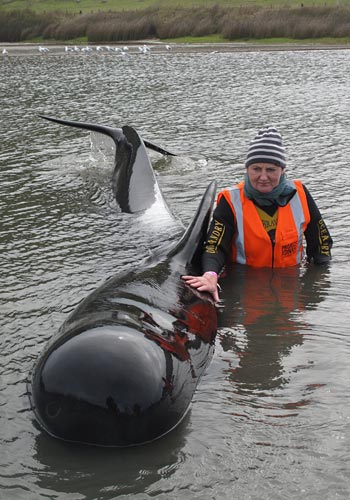
During the Spirits Bay stranding, when more than 70 whales came ashore on September 22, volunteers also had to spend many hours chest-deep in a chilly lagoon with their whales.
Once back in the water, you’d think the whales would be keen to get going and make a break for the sea. A few needed reassurance or a steadying hand, but most simply waited. It was as if they knew they had to save their strength for the longest road trip of their lives.
Among the helpers was Kate Malcolm of Tutukaka, who spent much of a night and a day in the water with “Wilbur”, a large male who survived against the odds; and Kahi Harawira of Te Kao, who slept standing up with an arm draped gently around his whale, his bushy beard resting against its dorsal fin.
Other volunteers made the work of the whale minders possible. The people of Te Hapua, for example, emptied their cupboards and supplied hot food and drink 24 hours a day.
And when the time came to move the Spirits Bay whales 50km by road to Rarawa Beach — thought to be the biggest overland whale rescue ever attempted, in terms of both distance and the number of whales moved — it was a logistical exercise on a scale rarely seen in Northland, requiring trucks, diggers and tonnes of equipment at one of the region’s most isolated beaches.
There are those who say the effort and expense is not justified, that strandings are a natural occurrence and only a small proportion of the beached whales will ever be saved.
That may be true, but there was something profoundly moving about seeing so many people, from so many walks of life, drop everything to help another species.
I feel privileged to have seen not just one but two mass strandings.
But what will stick with me, even more than the whales’ screams, is the compassion of the humans who tried to save them.


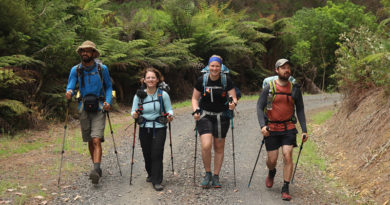
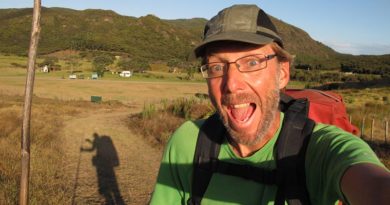
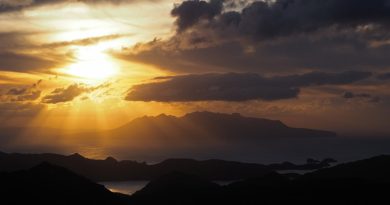
A very moving report. This has really captured my heart and brought tears to my eyes.
Kia ora Kerry.